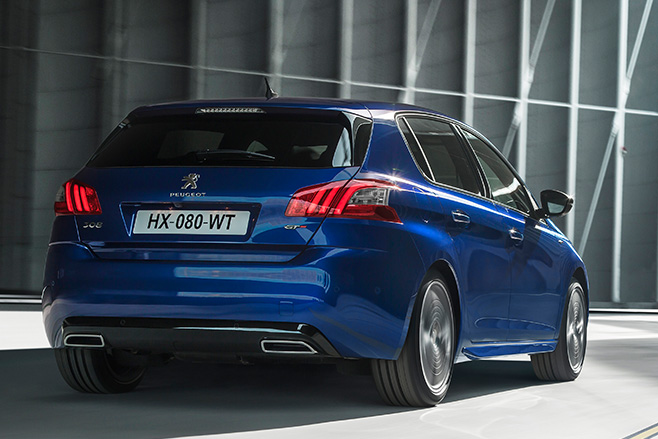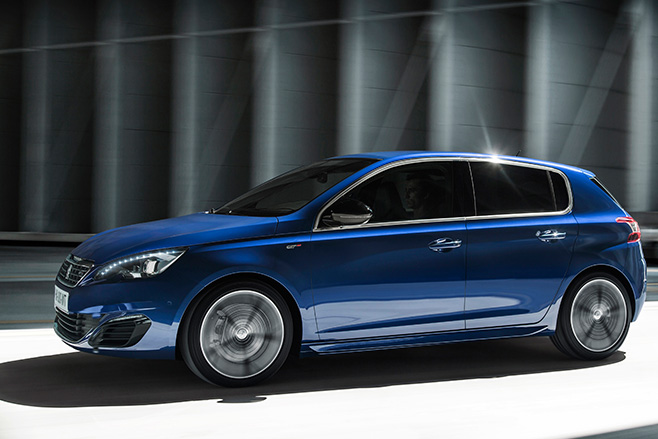
So, what is it?
A ‘warm’ version of Peugeot’s refreshed 308 hatch, offered with a choice of four cylinder turbos; a 151kW/285Nm 1.6-litre petrol matched with a six-speed manual, or 133kW/400Nm 2.0-litre diesel with flappy paddle six-speed auto.
Why should I care?
As a brand, Peugeot remains an unconventional choice in this market. But the second-gen 308 picked up the European Car of the Year award last year, so the car the GT is based on already has a solid fan-base.
And the French maker has serious form when it comes to performance hatches. The 205 GTi is an all-time great, and the current 208 GTi has been raising eyebrows and smiles since it arrived here in 2013.

What’s new about it?
The GT is positioned as a genuine grand tourer, rather than a purely sports-focused hot hatch. That’s likely to come sooner rather than later in a production version of 2013’s (202kW/330Nm) 308 R Concept.
The newcomer features unique 18-inch alloy rims, a lower ride (7mm front / 10mm rear), spring and damper rates stiffened by between 10 and 20 per cent (depending on drivetrain), as well as driver-adjustable steering weight and throttle calibration.
There’s also an amplified engine note (more on that later), specific interior trim elements, red instrument illumination, and a multi-function display, reading out on power and torque, turbo boost pressure, as well as longitudinal and lateral Gs.
Car-spotters should also look out for chrome on the grille bars, front fog lamps, window surrounds, and dual exhaust

That’s all fine, what’s it like to drive fast?
We scored several hundred kays worth of GT wheel time during a launch drive program around the NSW-Victoria border towns of Albury Wodonga; on the sweeping backroads in the surrounding Murray River hinterland, and a twisting 1.6km driver training circuit operated by Wodonga TAFE.
It became clear immediately the GT’s outstanding dynamic attribute is supreme body control. Even on fast, dipping and twisting sections, the strut front, torsion beam rear suspension manages to not only keep pitch and roll in check, but make sure yaw movement doesn’t get out of hand. All very predictable and stress-free.
Acceleration in both variants is brisk rather than quick, with the diesel’s meatier mid-range running out of puff towards the top end, while the petrol loves to rev towards its power peak at 5,000rpm.
In Sport mode (available via a console rocker switch), steering weight loads up, while road feel remains good (rather than great). Throttle response sharpens, and in the diesel, gear shifts become more urgent. Overall, the 308 GT is an enjoyable drive.

And driving home from the city?
Yes, it’s a subjective call, but we think the 308 is a beautifully resolved design. Its proportions, key character lines, and overall stance set it apart from the medium hatch crowd, and the GT’s interior is just as striking.
Minimalist, in Scandinavian style, the 308’s cabin has the cool, reserved air of an upmarket Norwegian ski lodge, accented by a subtle combination of soft-touch plastics and brushed metal finishes.
Ride comfort around town over imperfect surfaces is extremely good. The sports seats are comfy and both engines are amazingly quiet.
Anything bad about it?
Several points on the negative side of the ledger.
First, you’re either a fan of Peugeot’s ‘Head up’ instrument display or you’re not. This ‘main instruments above small steering wheel’ arrangement was pioneered in the 208, and lives on here.

We think it’s an answer to a question nobody was asking, but Peugeot counters with a raft of ergonomic pluses. And speaking of counters, we’re not sure why the rev counter winds anti-clockwise, but we are sure it doesn’t add any meaningful benefit.
The ‘amplified engine note’, mentioned earlier, is also a bone of contention. Imagine the fashion model in waiting that’s laughing at all your jokes, and making laser beam eye contact is actually not of the gender you assumed they were. Nothing wrong with that, but it’s not your thing, and burning interest cools immediately. That’s kind of what it’s like when you realise the GT’s rorty engine sound (in Sport mode) is a synthetic facsimile pumped through the audio system.
And finally, ‘Manual’ mode on the diesel’s six-speed auto… isn’t. It changes down a couple of ratios when it wants to, and always shifts before the rev limiter. Sure, head-butting the rev-limiter on a regular basis isn’t necessarily a good idea. But if the mode says manual, we reserve the right to be stupid when we want to.
How much would I have to pay? And is it worth it?
Cost-of-entry is $41,990, and that number brings a lengthy list of standard equipment with it.
Highlights are a 9.7-inch infotainment touchscreen, sat-nav, rear-view camera with front parking sensors, ‘Jukebox’ music storage, electric lumbar support with massage function on the front seats, ‘Open & Go’ keyless entry, alloy pedals and door sills, LED headlights with integrated DRL’s, and cool animated indicators (as in, they swipe across the lens when activated).
Then there’s the standard ‘Driver Assist’ pack, which adds active cruise, Emergency Collision Alert, Emergency Collision Brake, Park Assist, and Blind Spot Monitoring. That’s a h-e-a-p of fruit for a $42k price point.
Would you take the 308 GT or VW Golf GTI?
Peugeot’s at pains to point out this is a GT, rather than a GTi; the inference being a GTi is compromised by overly stiff suspension and a less refined drive experience. Problem is, the Golf GTI is faster and delivers a superb combination of dynamic ability and comfort. No compromise.
On the flip side, the petrol only GTI while more powerful is heavier and thirstier. And while the features list is impressive, it can’t match the Peugeot’s standard spec. Close call, but we’d still opt for the German benchmark.
Click here to find out more about the Peugeot 308 GT.



